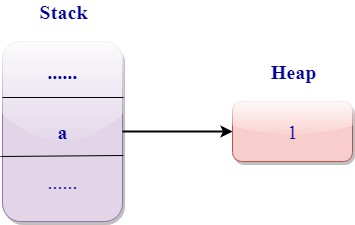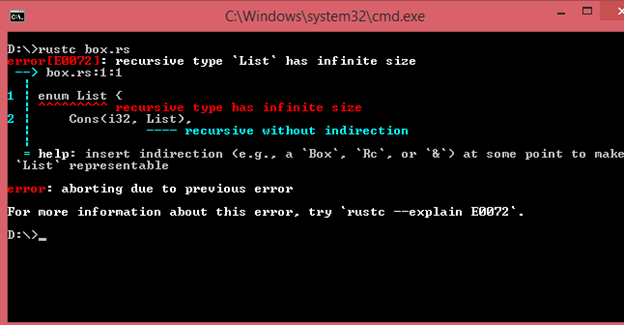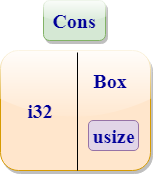📌 相关文章
- 检查数组的素数元素的和是否为素数
- 交换两个数字的Java程序
- gogole - 任何代码示例
- depmod:未找到 - Shell-Bash 代码示例
- 可以刻在矩形中的最大可能的圆
- 如何在python代码示例中打印字符串
- 给定2D数组中的最小和子矩阵
- Python – GTK+ 3 中的网格容器
- &-Tex命令(1)
- 微软面试经历 |第 95 组(IDC 校内)
- 素数的递归程序
- Python|提取过滤的字典值
- python 跟踪表 - Python 代码示例
- html 文本框 - Html 代码示例
- 在 termux 中安装 msf - Shell-Bash 代码示例
- 检查是否可以通过与上一跳重复多次,少跳一次或相同数目的索引重复跳转来到达已排序数组的末尾
- 从0到N的连续数字的汉明差总和|套装2
- ruby 数组减数组 - Ruby 代码示例
- 2的最高幂除以二进制表示的数字
- nodejs 临时文件 - Javascript 代码示例
- 弗吉尼亚技术 - 任何代码示例
- 通过翻转单个子数组的所有元素的符号来最大化数组的总和
- 链表中第二小的元素
- 下一页数据表时弹出窗口不起作用 - Javascript代码示例
- 国际空间研究组织 | ISRO CS 2011 |问题 17
- 不等于 java 代码示例
- DXC技术面试体验(校内)
- laravel api 路由 - PHP 代码示例
- mysql 将变量设置为今天的日期 - SQL 代码示例
📜 锈盒T
📅 最后修改于: 2021-01-08 13:57:28 🧑 作者: Mango
框
- Box
是一个智能指针,它指向在T类型的堆上分配的数据。Box 允许您将数据存储在堆而不是堆栈上。 - Box
是一个拥有的指针。 - 除了将数据存储在堆上之外,存储盒没有性能开销。
- 当Box超出范围时,将调用析构函数销毁所有内部对象并释放内存。
使用盒子将数据存储在堆上。
Box
fn main()
{
let a = Box :: new(1);
print!("value of a is : {}",a);
}
输出:
value of a is : 1
在上面的示例中,a包含指向数据1的Box值。如果我们访问Box的值,则程序将输出“ 1”。程序结束时,将重新分配Box。该框存储在堆栈上,它指向的数据存储在堆上。
让我们看一下上面例子的图示:

缺点清单
- Cons代表“构造函数” 。
- Cons list是一种数据结构,用于根据两个参数构造一个新对,该对称为List。
- 假设我们有两个元素x和y,那么cons函数cons将“ x放到y”意味着我们要通过将元素x首先放置,然后是元素y来构造新容器。
- 缺点列表包含两个元素,即当前项目和最后一项。缺点列表的最后一项是Nil,因为Nil不包含下一项。
现在,我们创建包含cons列表的枚举。
enum List
{
cons(i32, List),
Nil,
}
在上面的代码中,我们创建List类型的枚举,其中包含i32值的cons列表数据结构。
现在,在以下示例中使用上面的列表类型:
enum List {
Cons(i32, List),
Nil,
}
use List::{Cons, Nil};
fn main()
{
let list = List::Cons(1,Cons(2,Cons(3,Nil)));
for i in list.iter()
{
print!("{}",i);
}
}
输出:

在上面的示例中,Rust编译器抛出错误“具有无限大小”,因为List类型包含递归变量。结果,Rust无法找到存储List值需要多少空间。通过使用Box
使用盒子获得递归类型的大小
Rust无法弄清楚存储递归数据类型需要多少空间。 Rust编译器在前一种情况下显示错误:
= help: insert indirection (e.g., a 'Box', 'Rc', or '&') at some point to make 'List' representable
在上述情况下,我们可以使用Box

让我们看一个简单的例子:
#[derive(Debug)]
enum List {
Cons(i32, Box),
Nil,
}
use List::{Cons, Nil};
fn main()
{
let list = Cons(1,Box::new(Cons(2,Box::new(Cons(3,Box::new(Nil))))));
print!("{:?}",list);
}
输出:
Cons(1, Cons(2, Cons(3, Nil)))
注意:如果我们使用Box